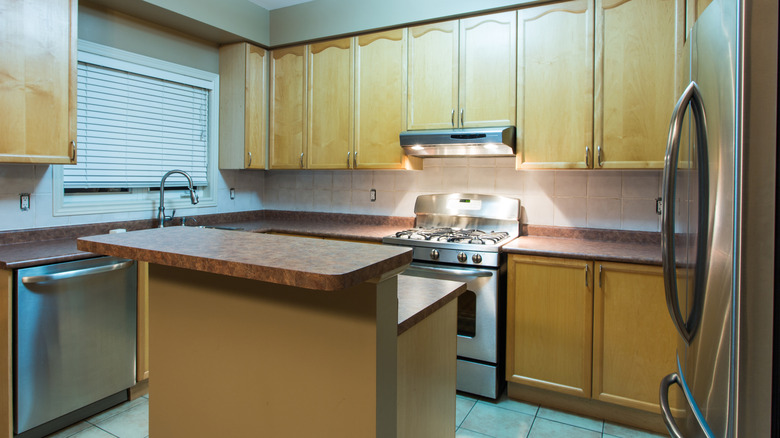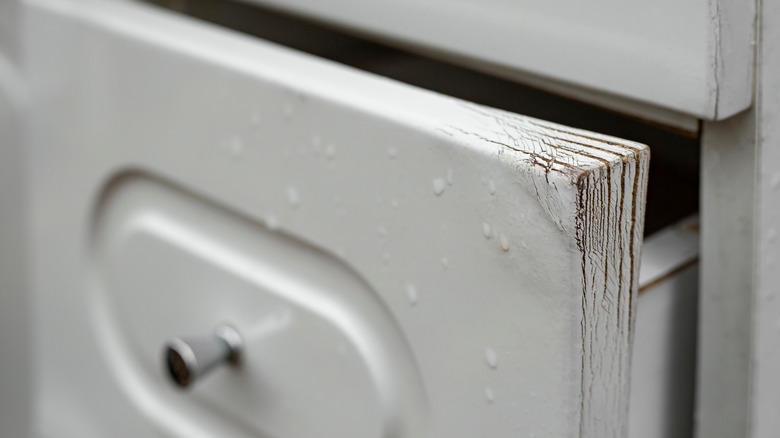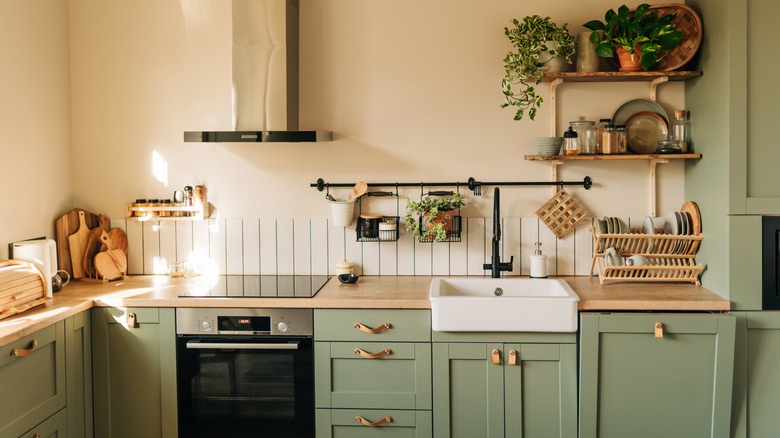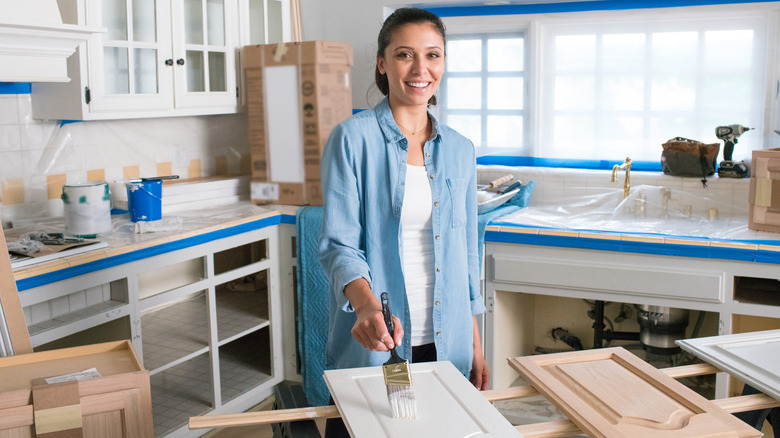Signs It's Time To Replace Your Dated Kitchen Cabinets (And Styles We'd Recommend)
We may receive a commission on purchases made from links.
Kitchen cabinets are an important investment, especially as these rooms have become the focal point of our homes. As a professional woodworker who grew up in a cabinet shop, kitchen cabinets have long been in my wheelhouse. Because they are such an vital part of our home, upgrading the designs and functionality of kitchen cabinets is an ongoing process. While the basic function of the cabinets remains the same — practical storage of cooking gear and dining ware — the scope of options available to do that in a modern kitchen are many and amazing. For those reasons, knowing when to replace kitchen cabinets is a common question I get asked. Like so many home improvement questions, there is no single straightforward answer, but you should look at function, style, color, and personal preference.
Cabinet style is a big reason why folks want to replace their cabinets. Like all trends, cabinet styles change over time. The groovy dark-stained oak cabinets I built in the late 1980s are not exactly stylish today. Whether we're talking about the color, material, door styles, soffits, no soffits, drawer slide types ... cabinet styles are always changing. Some are more transitory than others.
There is no "right" style, as personal taste is the most important consideration. My wife loves our kitchen cabinets. The boxes and doors are original to our 1940 Cape Cod home. We have upgraded many parts of the kitchen, but she does not want me to touch the doors and drawers. To be fair, they look great. But here are some signs that will help you know if it is time to replace your cabinets.
Do your cabinets function like they should?
The primary concern with kitchen cabinets must be function. Do the doors close properly or are some of them warped? Do the drawers open and close without sticking or jumping off their tracks? Are the drawer fronts secured to the drawer boxes? Are the shelves secure, or do they bend along their length? Are they adjustable? Have the cabinet boxes suffered water damage or have a mildew smell? Along with basic functionality, do they lack pull-out shelves or other accessories that would make your kitchen more efficient?
You get the idea. Sometime functionality degrades slowly over time and we hardly notice it. And in addition to basic functionality, look to see how your kitchen stacks up aesthetically. See if the finish on your doors and drawer fronts appear dated, or if they are breaking down with age and use. Look for scratches, water spots, paint peeling, or clashing colors or styles. While aesthetics are not the end-all, be-all, the benefit of a kitchen that is inviting and pleasant to look at is a real value in your day-to-day routines. An ugly kitchen can lower your house value and the quality of your life.
Replacing poorly functioning cabinets is simply a practical idea, but replacing a kitchen that is an eyesore is often a good investment in terms of house value and the enjoyment you get out of your home. At the same time, replacing your kitchen cabinets is an expensive decision to make. But once you do, there is still much to consider.
Adrift in a sea of cabinet styles
It is easy to get overwhelmed at the myriad options to consider when choosing new kitchen cabinets. For most people, I think it's beneficial to have help from a designer to winnow down the selections and develop a budget. With that said, one trend worth considering is medium to dark wooden cabinets. Traditional wooden cabinets are more expensive than painted cabinets, but are durable and retain their value over time. Painted cabinets are always a great option, but I would avoid very bright or deep colors.
Earth tones are popular now, but again, avoid the extremes. Choices like that may not age well. Speaking of styles that hold their value, Shaker-style cabinets, with their elegant but simple lines, are perennial favorites whether in natural wood or painted. Considering hardware, vintage options like these Zernmiarder green ceramic knobs or no visible hardware at all are both trendy. One option in the "love it or hate it" category are open-shelved upper cabinets. Uppers without doors are popular at the moment.
Two options that I strongly recommend are soft-close door hinges and self-closing drawer slides. They add quiet functionality to opening and closing doors and drawers — the two actions most common in a kitchen. There are a host of cabinet accessories that also enhance your kitchen experience. You can select from a wide variety of pull-out shelves, some with self-closing features, which makes accessing the contents of your lower cabinets easier. There are under-counter organizers, pull-out "pantry" shelving units, pull-down shelves for upper cabinets, and a host of lazy Susan-type hardware. But remember, they must fit within your budget.
Can you restore instead of replacing your kitchen cabinets?
As mentioned, replacing your old cabinets with brand new ones is a big and expensive decision to make. But what about upgrading your existing cabinets? If your cabinets are basically sound and are just looking a little long in the tooth, the answer is yes. Painting your existing wood cabinets can do wonders, especially if the color or finish is out-of-date or breaking down. Follow the basic rules of painting: clean deeply and sand the surfaces smooth first. Fill any holes or cracks with wood filler. Remove the doors and take all of the hardware off and then apply a high-quality paint. If you have the skills and your cabinet doors will accommodate the change, replacing the hardware — hinges, handles and pulls — is another upgrade that can make a big difference. You could remove a couple of doors to create that upper cabinet shelving look — and don't overlook after-market accessories like pull-out shelving.
A more adventuresome option would be to order new cabinet doors. There are companies that will make new doors for your existing cabinets. You choose the look and style of the doors from a wide selection. The downside is most of them will be sent to you unfinished. Some will finish them for an extra charge, or have them pre-drilled for hardware. Obviously, this is more costly and requires more work than painting your cabinets, but much less expensive than buying new cabinets. Even simply painting your cabinets will require that a good bit of time and effort be invested. However, for many of us DIYers, that's fun.
Consider the many benefits of a new kitchen
As a professional woodworker who is capable of creating custom cabinets from scratch, I confess that I have used all of the options above to provide all new cabinets or to simply improve the existing cabinetry for my homes and for others. And I've also ignored my own advice to my regret. I learned about not using a kitchen designer the hard way. The reworking I ended up doing far outweighed the cost of a designer. When I restored a 1906 Foursquare home, I built the kitchen cabinet boxes but ordered the doors made for me. In the same house, I made custom doors to refit some existing built-in cabinetry. In my last house, I upgraded the kitchen by painting the cabinets, while also adding some soft-closing hardware to them. And I was very happy with the outcome in all those situations.
In my homes, our kitchen was the center of our family life. And having an inviting, beautiful, and highly functional kitchen only made that better. Deciding to invest in all new kitchen cabinets is no small thing in terms of cost and the disruption that the upgrade will cause. But, as long as it is not extravagant, upgrading your kitchen is a good investment in your home's value. It is one of the few big-ticket upgrades that do well in that regard. And after all is said and done, organizing your kitchen cabinets properly will make household chores flow more smoothly. Having a kitchen that you love will be worth the time and effort.




